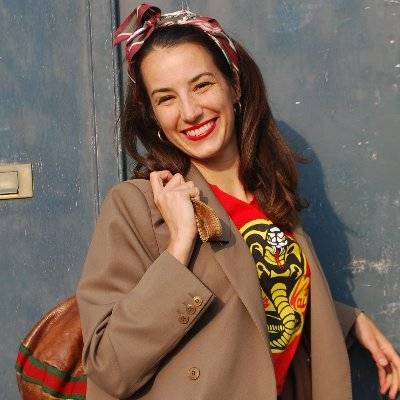When we think of the genre of magical realism, we often think about South American literature, where spirits of the past, food and social issues blur together. However, for Emirati artist Moza Almatrooshi, this blending of imagination and everyday life is something that has always been under the skin of the Arab world.
“The magical realism that resonates with me the most is the religious mythology that is born out of the Arabian Peninsula,” she tells me. “Until recently, there were minimal efforts to unearth all the erasure of pre-Islamic mythologies and histories in the region. I became interested in all the negative spaces that were vacant and allowed for a re-imagined social landscape to form.”
The artist’s studio is located in the heart of Sharjah in the UAE. She describes it as a wonderful neighbourhood just walking distance from the Sharjah Art Museum, and the art spaces of Sharjah Art Foundation. “I have a small kitchen where I make pastries, and I have a common area in my studio with a fully stocked food book library for visitors. They are welcome to come and spend time reading books on food and art, food history, food and politics, food and fiction, and food itself!”
Indeed, one of the most recognisable aspects of her work is a focus on cooking and storytelling. She looks at the act of preparing food as an artistic gesture and a mode of translation. “Food is imbued with themes of irreversibility, violence, romance, colonisation, narrative; the list goes on,” she explains. “It felt potent as a tool to rely on that has been able to carry all of this historically through to present times.”
Art as a force for Libyan women’s empowerment: interview with Shatha Sbeta
Interested in language and alternative truths, Almatrooshi looks at the homogenisation of religious and national identities. The female narratives in particular are at the core of her exploration. For the artist these are not just theoretical concepts, but something stemming from lived experience. “I am reactive in my work and tend to produce research and artwork that are outcomes of my own political, social or geographical environment.”
As a multidisciplinary artist, Almatrooshi’s works range from video, to photography and installation, with writing being a big part of her way of expressing herself. Mostly, though, it’s the topic that chooses the right medium for the idea to take shape. “Where I pause with my findings is where I’m able to determine how the work will materialise.”
While she studied design architecture, she now devotes herself to a full-time art practice that is only influenced marginally by this background, if not by taking spatial politics and conditions into account. However, by being in London to further her art studies through a Master of Fine Arts degree at the Slade School of Fine Art in London, she was able to develop a different outlook on her own native culture. “I suppose that was a natural reaction. Being able to have a vantage point from a distance on where I was living and working, as well as where most of my material and research is from, broadened my perspectives,” she reflects. “But I was also wary about developing a western gaze on myself and my practice. Self-orientalising was certainly in the forefront of my mind as something that I had to recognise and work against.”
Almatrooshi finds the most satisfaction in collaborative work; her performance work “Praise Hiya”, curated by Loren Elhili and Sabrina Mumtaz Hassan, and presented by Laundry Arts in London, for example. “I worked along with five women to choreograph a set of movements to reimagine what a private moment in a temple venerating the deities of pre-Islamic Arabia might have looked like. The work primarily focused on a deity named Al-Lat, who was revered as a goddess of vegetation and fertility. In examining Al-Lat’s role in pre-Islamic peninsular societies I was able to find many interesting pieces of information about harvesting and agricultural practices.”
The brighter side of Arab cinema: interview with Palestinian American director Suha Araj
The artist is not only exhibiting in galleries, but is also using social media to connect with a wider audience. During the peak of the pandemic, she became busy online as it became increasingly important to stay connected and form communities throughout distressing times. Along with Cairo-based artist Marwa Benhalim, she started a research platform called Attempting Abla Nazira, which looks at the role of women now and then in the kitchen, as chefs, cookbook authors and working with food in general in the region. “The project is continuous; Marwa and I recently ran a residency programme in Sharjah to identify key points in the research and collect more information as we move forward.”
Almatrooshi relies on daily routines to support her art practice. “I have a schedule that ensures that I am done with admin work, applications and communications during the morning, then after lunch I move into working on my commissioned projects or works in progress, which can include experiments in the kitchen.”
At the moment, for her research she is following a beekeeper across the UAE to document his work, while he derives different varieties of honey from various types of flora. “There are many metaphors that lend themselves to this exploration,” she concludes. “It’s a work in progress and should become more resolved in a few months’ time.”
UPDATE: A previous version of this interview I corrected listed Moza Almatrooshi’s nationality as Saudi, this has was corrected on 26 May 2021, at 15:40 (UK)
















